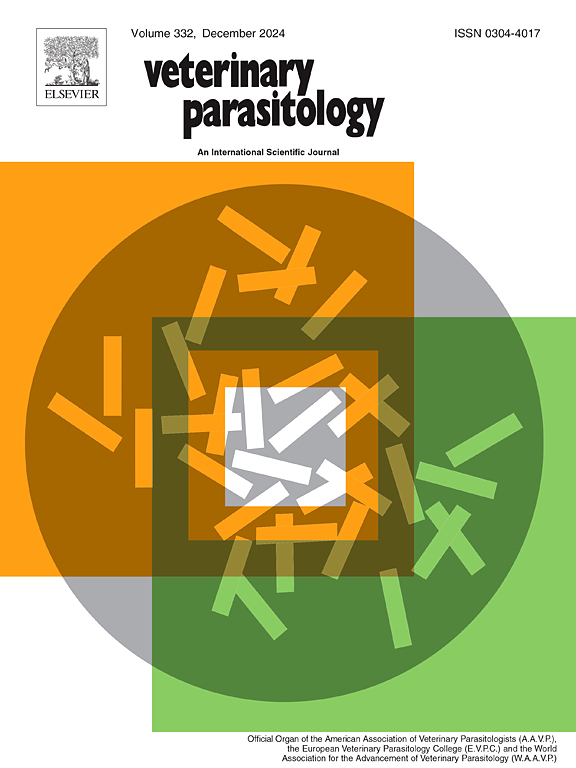In vitro susceptibility study of Amblyomma cohaerens and Rhipicepalus (Boophilus) decoloratus tick species to amitraz 12.5 % and diazinon 60 % acaricides in Jimma town, Ethiopia
IF 2
2区 农林科学
Q2 PARASITOLOGY
引用次数: 0
Abstract
The study was conducted to evaluate the in vitro efficacy of amitraz 12.5 % and diazinon 60 % against Amblyomma cohaerens and Rhipicephalus (Boophilus) decoloratus, and also to assess acaricide resistance using the Adult Immersion Test (AIT) in Jimma town, Oromia region, southwest Ethiopia. A total of 180 engorged adult female ticks of the two species (90 A. cohaerens and 90 R. decoloratus) were collected from local and crossbred cattle managed under extensive and semi-intensive systems. The ticks were immersed in amitraz 12.5 % and diazinon 60 % at field-recommended concentrations, and in distilled water for the control groups, for two minutes. Afterward, they were placed in an incubator at 27°C and 85 % RH for seven days. The oviposition responses of A. cohaerens and R. decoloratus were monitored regularly. The efficacy of each acaricide was assessed by comparing the mean egg mass laid by treated and untreated tick groups. The study results showed that ticks treated with amitraz 12.5 % died and did not lay eggs, while some ticks treated with diazinon 60 % survived and laid eggs after a seven-day incubation period. There was a significant difference (p < 0.05) between the two acaricides in controlling egg-laying in both species of ticks. The ticks in the control group that were treated with water survived and laid eggs. Amitraz 12.5 % at the field-recommended concentration achieved 100 % control, whereas diazinon 60 % achieved 91.3 % control. The study shows that both amitraz 12.5 % and diazinon 60 % significantly reduced egg laying in A. cohaerens and R. decoloratus ticks. The results also demonstrate that amitraz 12.5 % is more effective in controlling ticks and that there is a sign of emerging resistance of ticks to diazinon 60 %.
埃塞俄比亚Jimma镇cohaeramblyomma cohaerens和Rhipicepalus (Boophilus)脱色蜱对12. %和60% %杀螨剂amitraz的体外敏感性研究
在埃塞俄比亚西南部奥罗米亚地区的Jimma镇,采用成虫浸渍试验(AIT)对12.5 % amitraz和60 %噻嗪农对粘胶无足虫和脱色芽孢杆菌(Boophilus)的体外药效进行了评价,并进行了杀螨剂抗性评价。两种成年雌蜱共180只( A。cohaerens和90 R。从粗放和半集约化系统下管理的地方和杂交牛身上收集。将蜱按现场推荐浓度分别浸泡在amitraz 12. %和di嗪农60 %中,对照组浸泡在蒸馏水中2分钟。之后,在27°C和85 % RH的培养箱中放置7天。定期监测粘胶姬螨和脱色姬螨的产卵反应。通过比较处理组和未处理组的平均产蛋量来评价各杀螨剂的药效。结果表明,阿米特拉斯处理的蜱虫有12. %死亡且不产卵,而重嗪灵处理的蜱虫有60% %存活并产卵,潜伏期为7天。两种杀螨剂对两种蜱的产卵控制差异有统计学意义(p <; 0.05)。对照组的蜱虫经水处理后存活并产卵。在现场推荐浓度下,阿米特拉斯12.5 %的控制效果为100% %,而重嗪农60 %的控制效果为91.3 %。研究表明,阿米特拉斯12.5 %和重嗪农60 %均能显著降低粘胶扁虱和脱色扁虱的产卵量。结果还表明,12. %的阿米特拉斯对蜱的控制效果更好,60% %的重嗪灵对蜱有抗药性。
本文章由计算机程序翻译,如有差异,请以英文原文为准。
求助全文
约1分钟内获得全文
求助全文
来源期刊

Veterinary parasitology
农林科学-寄生虫学
CiteScore
5.30
自引率
7.70%
发文量
126
审稿时长
36 days
期刊介绍:
The journal Veterinary Parasitology has an open access mirror journal,Veterinary Parasitology: X, sharing the same aims and scope, editorial team, submission system and rigorous peer review.
This journal is concerned with those aspects of helminthology, protozoology and entomology which are of interest to animal health investigators, veterinary practitioners and others with a special interest in parasitology. Papers of the highest quality dealing with all aspects of disease prevention, pathology, treatment, epidemiology, and control of parasites in all domesticated animals, fall within the scope of the journal. Papers of geographically limited (local) interest which are not of interest to an international audience will not be accepted. Authors who submit papers based on local data will need to indicate why their paper is relevant to a broader readership.
Parasitological studies on laboratory animals fall within the scope of the journal only if they provide a reasonably close model of a disease of domestic animals. Additionally the journal will consider papers relating to wildlife species where they may act as disease reservoirs to domestic animals, or as a zoonotic reservoir. Case studies considered to be unique or of specific interest to the journal, will also be considered on occasions at the Editors'' discretion. Papers dealing exclusively with the taxonomy of parasites do not fall within the scope of the journal.
 求助内容:
求助内容: 应助结果提醒方式:
应助结果提醒方式:


